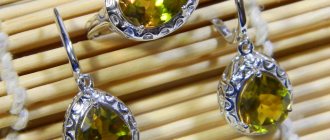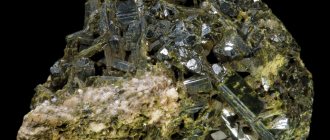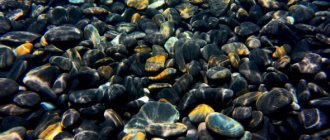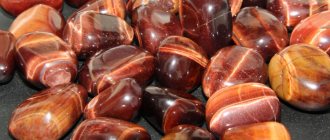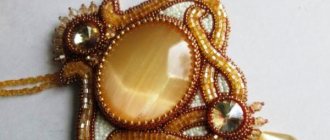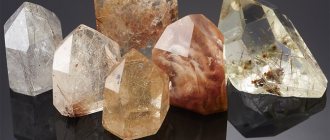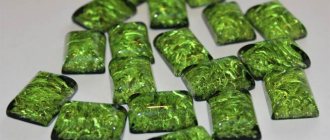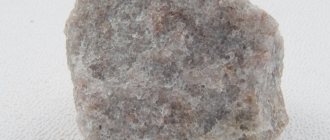| Category | Carbonates (minerals) |
| Title in English | Calcite |
| Formula | CaCO3 |
| Group | Carbonate group |
| Color | White, Colorless, Blue, Yellow, Green, Brown, Red, Orange, Pink, Grey, Black, Blue |
| Stroke color | White |
| Shine | Glass |
| Transparency | Transparent |
| singonia | Trigonal |
| Hardness | 3 |
| Cleavage | Very perfect |
| Density, g/cm³ | 2,71 |
| Kink | Conchoidal |
| origin of name | Calcite got its name thanks to the Austrian mineralogist Wilhelm Haidinger. He used the Latin word calx, which translates to quicklime. Haidinger based his work on the mineral's main industrial significance, namely the production of cement and lime. The mineral calcite is also known by other names. For example, lime spar or andromadas. |
| Morphology | Calcite crystals are naturally flat. Also, there are elongated rhombohedrons, scalenohedra and, less commonly, prisms. It appears in the form of staractites, chalk-like, as well as cocretionary forms or stalagmites. In the natural environment, it is found in the form of granular aggregates. |
The mineral calcite is often found under such names as “dog’s tooth”, “butterflies”, “angels’ wings”. They all differ from each other in crystal shape. The color palette of the mineral is also very diverse, and therefore calcite can safely be called the most diverse stone on our planet. It is very widespread - it ranks third among minerals after quartz and feldspar. It is easy to find even during a regular walk in the mountains. Thus, the Alps and Cordillera are built from calcite.
Calcite deposits
After feldspar and quartz, calcite is the most common mineral on Earth. Large deposits of calcite are located in the United States. Its honey-orange subspecies is mined there. Large crystals up to 6 meters in length were discovered in Iceland. In Russia, calcite deposits have been explored in the Urals and Transbaikalia. Like chalk, the mineral is widespread in the Donbass. Namibia is rich in calcite with the inclusion of malachite, and in the Congo and Morocco there are its combinations with cobalt.
Description and external signs
Calcite is a form of naturally occurring calcium carbonate and a rock-forming mineral. The name is translated from Latin as “lime”. Calcite refers to many types of minerals based on calcium. Other names of the breed are also popularly known:
- Paperspar – so named because of the transparent thin plates of calcium carbonate;
- Stone flower / rose – because has characteristic processes that look like petals;
- Skystone is the name given to the shiny variety;
- Stalactites and stalagmites are calcareous forms, of which there are many in caves.
International name: Calcite. This is one of the most common minerals on Earth. In its pure form it is transparent and colorless. Shades add impurities to it.
History of calcite
— Advertising —
Calcite has been known to the Majesty for a very long time, but it attracted attention only in the 17th century, when Iceland spar, one of its varieties, was discovered. Then the official name of the stone appeared, which comes from “calcis”, which is translated from Latin as lime. It is connected with the fact that in ancient times lime was extracted by burning calcite.
People began to build various buildings from calcite a very long time ago, but even now few people know how widespread this mineral is, even though they build houses from it, create sculptures and make food supplements.
History and origin
Lime spar is the most common in nature, in the form of a rock-forming mineral. This essential component is part of rocks. Calcite, as a biomineral, is the main component of the shells and shells of invertebrate animals.
Calcium carbonate tends to crystallize in the form of polymorphs, like Aragonite or Vaterite. The name of the mineral was assigned in the middle of the 19th century, at the suggestion of the mineralogist Wilhelm Heidinger. It is difficult to imagine how many years ago the limestone rock was formed.
Historically, the mineral is known to be present in the most ancient architectural structures, such as the pyramids in Egypt or the amphitheater and temples in Ancient Greece.
Calcite formation occurs in low-temperature hydrothermal processes. The mineral is resistant to natural conditions and is difficult to dissolve in fresh water. However, calcareous rock is easily washed away by waters with a high carbon dioxide content. As a result, craters are formed, from which karst caves grow, which have both a horizontal and vertical arrangement.
Physico-chemical characteristics of calcite
Pure, without impurities, calcite is white or colorless, it is transparent or translucent, depending on the crystal structure.
The color range of a mineral is directly related to the presence of certain impurities in its composition. For example, date nickel is green; cobalt and manganese – pink. Fine pyrite gives shades of blue and green. Calcites with iron impurities become yellowish, brownish, red-brown; with chlorite impurities - green. Carbonaceous substances are responsible for the appearance of an uneven black color. In the presence of bituminous substances, a yellow or brown color appears. The specific gravity of calcite crystals is 2.6-2.8 g/cm3, hardness on the Mohs scale is 3, step fracture, perfect cleavage, they have a glassy luster to pearlescent. With dilute hydrochloric acid the stone boils.
— Advertising —
Transparent crystals are characterized by birefringence: if you examine the stem through it, the latter begins to double.
In the event of an impact, the mineral breaks into fragments. When heated to 500°C and at elevated pressure, calcites turn into aragonites, and if they are heated further, they decompose into lime and carbon dioxide.
Chemical properties
Behavior in acids. It dissolves easily in dilute hydrochloric acid even in the cold with hissing (CO2 release).
Other properties
When compressed, accompanied by twinning, it becomes electrified.
Samples of some deposits exhibit the phenomenon of luminescence.
Crystals of calcite (white) and fluorite (yellow). Russia, North Caucasus, Belorecheskoye field
Diagnostic signs
Similar minerals. Aragonite, dolomite, amblygonite, chabazite, quartz, barite, gypsum, anhydrite, fluorite (easily differ in hardness, cleavage and behavior in dilute hydrochloric acid).
In coarse-crystalline varieties, it is easily recognized by its rhombohedral cleavage, relatively low hardness (easily scratched by the edge of a knife or needle), glassy or matte luster, and the rapid release of CO2 from a drop of HCl placed on the mineral or its powder on a glass slide.
Can be confused with dolomite, magnesite, gypsum. It differs from dolomite and magnesite in the nature of its reaction with hydrochloric acid. Gypsum, unlike calcite, can be scratched with a fingernail. Associated minerals. Quartz, siderite, sulfide ores, oxon ores, opal, chalcedony, barite, dolomite, fluorite.
Types of calcite
There are a huge number of varieties of calcite, which are distinguished by the shape of the crystals and their color. Among the most famous are the following types:
- Iceland spars are transparent calcites, without color, but with very pronounced birefringence.
- Anthraconites are black calcites containing bitumen.
- Simbirtsites are translucent stones, painted in yellow or reddish tones. A monument to this gem was erected in Ulyanovsk (formerly Simbirsk).
- Argentina - a subspecies with a lamellar structure and a silvery tint.
Physical properties
Optical
- Color. Mostly colorless or milky white, but sometimes colored with impurities in various (usually light) shades of gray, yellow, green, pink, red, brown and black.
- A colorless, water-transparent variety of calcite with strong birefringence is called Iceland spar.
- Glass shine.
- Trait. White, light grey.
- The tint is matte, sometimes (on the cleavage planes) pearlescent.
- Transparency. “Crystal clear”, transparent, translucent.
- Refractive indices^ Ng = 1.658 and Np = 1.486.
Calcite. Perfect cleavage in three directions
Mechanical
Reference hardness is 3. Brittle. Density. 2.6—2.8, for chemically pure crystals 2.72 at 23 °C
Cleavage is perfect in three directions (along the rhombohedron) (1010), as in all trigonal carbonates, which corresponds to weak directions of the halite-like structure.
The separation along {0112} is due to lamellar twins, which can be formed under the influence of pressure and are slip twins.
The fracture is granular and stepped.
The magical properties of calcite
Calcite crystals have significant energy potential.
They help to enhance the development of logical thinking and eliminate excessive passion. Amulets and talismans based on calcite are recommended for those involved in business, finance, law and treatment. They make representatives of these areas of activity far-sighted and protect them from mistakes. The calcite talisman will help motorists and professional drivers protect themselves from a traffic accident. It is important that calcites cannot be re-gifted; they are passed on exclusively by inheritance.
Before putting on the talisman, it is cleaned by placing it under cool running water, which quickly washes away previously accumulated negative energy from the stone.
Caring for stone products
In order for calcite jewelry to last a long time and retain its beauty, it must be protected from mechanical damage. The stone is quite fragile, it must be handled with care, not hit or dropped.
Also read: Petersite - a powerful mysterious stone
Acid destroys the structure of the gem, so it is better not to use chemicals for cleaning. To clean the jewelry from dirt, it is better to treat it in a soapy solution and rinse under running water. Moreover, without using brushes, since hard bristles will scratch the glossy surface of the crystal.
It is recommended to dry the products at room temperature or blot the moisture with a soft cloth. Avoid direct sunlight, as the color of the gems is “afraid” of ultraviolet radiation. Try not to keep calcite decorations near heating devices.
A fragile mineral is better preserved separately, since hard metal products can leave scratches or dents on it. After use, the jewelry is put away in a separate box, lined inside with soft fabric or a case; in rare cases, a velvet case is used.
Healing properties of calcite
A positive effect of calcite on the functioning of the human digestive system has been noted, and depending on the color, the mineral has a stronger effect on certain organs. Calcite gives its owner endurance and helps in tolerating high physical exertion. A ring with a gem on the little finger of the right hand or a pendant on the neck helps in the treatment of cardiovascular diseases. Calcite beads in a silver frame are used for colds.
Healing properties
Calcite has long been known for its ability to heal. The healing stone helps in the treatment of the following diseases of the gastrointestinal tract:
- gastritis;
- colitis;
- intoxication.
In ancient times, the mineral was widely used in witchcraft. Which organ was affected depended on the shade of the crystal.
- if the stone looks yellow, it means it cares about kidney health;
- the red mineral controls the condition of the intestines;
- orange calcite normalizes the digestive process and promotes spleen health;
- a blue-colored gem is responsible for the functioning of the respiratory system;
- green stone promotes rapid fusion of bones during fractures and heals joint diseases.
Also read: Carnelian - the meaning of the stone for a person
Jewelry with stones supports the body in the off-season, protects against acute respiratory diseases, and strengthens the immune system. The use of the gem gives an analgesic effect:
- reduces toothache;
- relieves migraines;
- relieves swelling, eye fatigue, relieves pain, the feeling of sand in the mucous membrane;
- accelerates the recovery process after an illness.
Important! Since calcite promotes tissue growth, the use of the mineral is contraindicated for various types of tumors.
Sectors of application of calcite
Calcite is known as a popular building material.
On its basis, for example, cement and lime are produced. In the chemical industry, the mineral is used in the production of caustic soda, and in the metallurgical industry - as flux. Most varieties of calcite are not suitable for making jewelry because the mineral is too soft, but, for example, satin spar and manganocalcite are used as ornamental materials.
How to identify natural calcite
The price of calcite is not too high, but there are a few “buts”. Construction grades are not suitable for decoration. But ornamental and semi-precious crystals can easily be counterfeited. No matter how cheap they are, the cost of plastic or glass is even lower. So fraudsters make significant profits by passing off counterfeit goods as genuine.
Transparent calcite must visually magnify objects, like a magnifying glass.
It is especially important to be able to distinguish a fake from a natural stone if you are buying it for treatment or magical practices. In this case, you will be primarily concerned about the energy properties. Calcite, like any other breed, has them only if it is a natural specimen.
The main difference between natural stone and artificial stone is defects. If you look closely at its thickness, you will notice uneven coloring, microcracks, multi-colored inclusions and air bubbles. A fake is always flawless, no matter how paradoxical it may sound.
If you are purchasing Iceland spar, the most popular type of limestone among jewelers, pay attention to how it refracts light. Double refraction is its main and unique property. The mineral acts as a magnifying glass; it is not for nothing that it was previously used to make binoculars and telescopes.
This feature is called optical anisotropy. It is possible to imitate it, but this will sharply increase the cost of a glass fake. It would be unprofitable to sell such a fake for the sake of excess profits.
Calcite colors
The color palette of calcite is very diverse. Most often it is either colorless or has light, delicate shades. Impurities of other elements can give calcites different colors: from lilac to crimson, from green to blue, from honey-yellow to brown. Blood-red coloring appears in the presence of small grains of cinnabar, blue, green, blue - with copper carbonates.
Varieties and photos of calcite
Transparent, birefringent calcite (doubles the image viewed through it) is called Iceland spar, very fine-grained calcite is called lithographic stone, foliated calcite is called paper spar.
Pearls are also a type of calcite. Pearls can be soft pink, white, yellowish, golden, bronze, greenish, bluish, dark gray, blue-black, black with a silver tint. Its shine is pearlescent. The size of the pearl ranges from a poppy seed to a pigeon egg, rarely more.
Another type of calcite is marble onyx.
Iceland spar. Photo by Gunnar Raez Pearls in a shell Onyx Marble
Calcite and zodiac sign
Calcite is a very friendly stone and willingly helps all people, regardless of their zodiac affiliation. The only exception is Scorpio, with which very light calcite does not get along. It is believed that Scorpios are more prone to black magic. Blue calcites are perfect as protective talismans for Cancers, green ones - for Capricorns.
Calcite stone: properties, description and purpose
Transparent calcite stone
Calcite comes in many interesting varieties, such as Iceland spar. This is birefringent transparent calcite with the unique ability to bifurcate objects viewed through it. The finest-grained type of mineral is called lithographic stone. And leafy calcite is known to professionals as paper spar.
A striking representative of this biomineral is pearls. When it comes to such a gem as pink calcite, then, first of all, it concerns amazing natural beads from the seabed. Cobalt calcite is also among this color variety, but with a purple tint. The result is a delicate color thanks to cobalt inclusions.
Orange calcite is more often identified with simbircite, a unique stone found in one single place on the planet. What pearls and simbircite have in common is that both gems are a product of the vital activity of mollusks.
A variety such as marble onyx deserves no less attention. This is a beautiful banded-zonal ornamental stone.
It is formed due to the intergrowth of carbonate fibers with other rocks. But the oldest rock, marble, is calcite in its purest form. Less known to a wide range of people are such types of mineral as argentine, stinking spar, manganocalcite.
Interesting facts about calcite:
- Calcite is a real record holder for the variety of shapes and colors among all existing minerals. There are more than 700 varieties of it. In the caves there are stalactites and stalagmites made of calcite, beautiful, bizarre-shaped “pearls of caverns” and other aggregates.
- Calcite is one of the ten standard stones, and ranks third on the Mohs scale.
- One of the most beautiful natural structures on our planet, the Great Barrier Reef (Australia), is built precisely from calcite. It reaches approximately 2,000 km in length.
- The ratio between the weight of calcites on the ground and the surface they cover is 1:10. The earth's crust contains about 4% of this mineral, but by area it is 40%.
Crystallographic characteristics
Trigonal syngony
Symmetry class . Ditrigonal scalenohedral - 3 m. V. With. L36L23PC. Etc. gr. R3–c (D63d). a0 = 4.98; с0 = 17.02. , ath = 6.42 A, a = 101°55′, Z = 4 for a cell of a fused rhombohedron or a0 = 4.98 A, c0 = 17.02 A, Z = 6, respectively, for a hexagonal cell, the unit cell has: agn = 6.37 A, a' = 46°07′, Z = 2
Crystal structure
The arrangement of ions in the unit cell is conformal to the cleavage rhombohedron. The Ca and CO3 ions are located as in face-centered lattices.
Main forms : The habit of calcite crystals is extremely varied, mainly prismatic [0001], tabular along {0001}, rhombohedral with shapes {0142}, {0221}, {4041}, rarely {1011}, scalenohedral {2131}. In contrast to other carbonates isostructural with calcite, for each of which ten or fifteen forms are known, for calcite there are more than 600 of them. This is undoubtedly due to the stability of the structure of other carbonate minerals, while calcite has a distorted structure to the limit, above which when large intrusions occur cations, the scheme of orthorhombic aragonite is stable. This may explain why calcite is quite common in crystals, while other trigonal carbonates prefer the aggregate form or only {1011} rhombohedrons, which are rarer for calcite. The main crystallographic forms of calcite: m {1010}, f {0112}, and {2131}, c {0001}, g {UM}, {0221}, {4041}, {16.0.16.1}, {1120}. Changes in the habit of calcite crystals are most likely controlled by changes in the supersaturation of the solution (due to a decrease or increase in temperature), which affects the development of crystallographic faces with different reticular densities. (0001) D (1011) — = 44°38′, (1011) D (1101) = 74°57′, (0110) D (0ll2)_=63°44′, (2131) D (3121) = = 35°35′, (0001) D (0221) = 63°08\ (4041) D (4401) = 114° 10′. Twins at {0001} and {0112} are quite common, the latter often lamellar; on {1011} and {0221} are more rare.
Calcite. Druze of rhombohedral crystals
Form of being in nature
The appearance of crystals. Calcite crystals
very diverse, mainly rhombohedrons and scalenohedra. Calcite occurs in single crystals and druses.
Crystals found exclusively in voids can be very diverse. The most common are scalenohedral crystals, less often tabular or lamellar, prismatic or columnar, rhombohedral - more often in the form of sharp rather than obtuse rhombohedrons.
80 different rhombohedrons, over 200 scalenohedra and more than 1000 combinations of them have been installed.
Doubles are common . Typically, the twinning plane is the pinacoid plane (0001) or the face of an obtuse rhombohedron (011–2), along which polysynthetic twins are often formed in marbles and crushed limestones (such twinning can be obtained artificially by applying pressure from the tip of a knife to the edge of a calcite fragment knocked out along the cleavage) . Less commonly, such a plane is the face of a commissural rhombohedron (101–1), etc.
Aggregates. Calcite occurs in the form of parallel and subparallel intergrowths of fibrous masses (satin spar), stalactites, oolitic, coral-like intergrowths
It is also common in solid dense crystalline granular aggregates (limestone, marble), earthy masses (chalk), lamellar and concretionary formations in the form of granular veins, nests and individual inclusions. Often it appears as sintered forms in the form of stalactites and stalagmites.
Druses of calcite crystals, together with other minerals, are observed, as already indicated, in voids. Quite often there are coarse-grained aggregates of transparent or translucent calcite with perfect cleavage of individual grains, which is striking. Veined asbestos-like calcite (satin spar) with a silky sheen is rarely observed, the fibers of which are located perpendicular to the walls of cracks in the rocks. “Sinter” formations of calcite in the form of stalactites and stalagmites in caves among limestones are widely known. Granular solid aggregates in large dense masses are called marbles. Dense cryptocrystalline varieties of calcite rocks, often layered and rich in fauna, are called limestones. Loose limestones containing minute foraminiferal shells are known as chalk. There are also oolitic limestones - “caviar stone”. “Calcareous tuff”, or travertine, is the name given to spongy formations of calcium carbonate that occur at the outlets of both cold and hot mineral springs saturated with lime ( calcite in these cases is formed by the recrystallization of precipitated colloids of CaCO3 or aragonite).
Sometimes, in connection with the deposition of carbonic lime from hot springs, finely striped translucent dense varieties, known as “marble onyx,” are formed with a remarkable pattern, however, such formations are also associated with cold-water processes (karst).
Calcite. Crystals, cleavage punches
Calcite jewelry
Calcite is used quite rarely in jewelry due to the properties of the stone. But still, some craftsmen cut the stone, place it in a frame and make jewelry from it of the rarest beauty. Calcite is rarely used to make bracelets, but more often into earrings, pendants and necklaces. This is explained by the fact that calcite is a very sensitive mineral to damage.
Much more often, calcite is used to make jewelry, amulets and souvenirs, which are very popular. Due to the magical and healing properties of the mineral, demand for calcite products never falls. Plus, brightly colored stones look beautiful on their own.
How to distinguish natural stone from fake?
The most reliable way to check calcite for authenticity is to use any acid. One drop will be enough to start a violent chemical reaction.
Upon impact, the mineral will crumble into small crystals of regular shape.
Of course, the buyer will not verify the authenticity of the calcite using the above methods. He will have to pay attention to the weight, external data of the stone and rely on his own feelings.
Origin of calcite
Calcite stone photo
The origin of calcite stone in the natural environment goes in different ways.
Often calcite veins are the product of solidification of hot solutions with calcium carbonate, which are thrown out by magma chambers. And near mineral springs there are deposits that are otherwise called calcareous tuff. Both are hydrothermal origins.
A skeleton made of a substance with the formula CaCO3 is built by many marine inhabitants, organisms of the lower class. After their death, entire limestone strata accumulate. An example of mineral formation inside shells is the growth of pearls. This is the deep origin of calcite.
Stone is also a component of many metamorphic and sedimentary rocks; it is found in the form of skeletal remains, in grottoes (stalactites and other similar formations), in the voids of volcanic lavas.
The mineral's companions are sulfides (if it was formed in ore veins), opal, chalcedony (if we are talking about volcanic formation).
The magic of calcite
The mineral has powerful magical properties. Calcite helps to reveal extrasensory abilities in the one who wears it. Develops the gift of foresight, helps to better understand people. When worn, this talisman changes a person’s worldview and expands his consciousness, making him look at the world with different eyes.
Protects against the evil eye and damage, and also protects the owner from minor troubles.
Helpful information
If the stone is lost, all the magical abilities that this mineral bestowed on the owner will be lost. In this case, another person will not be able to take advantage of the properties of calcite; it will play the role of an ordinary decoration.
Calcite cannot be given as a gift, it can only be passed on by inheritance.
Types of stone and their characteristics
There are many forms of calcite, the most common of which are:
- Marble. Consists exclusively of calcite, a common rock, one of the most popular varieties. There are many deposits around the world. Used in construction, for the manufacture of monuments and tombstones, for cladding buildings. Fireplaces, fountains, countertops, flowerpots and much more are also made from marble;
- Iceland spar. It was first discovered in Iceland. Evenkia is the only place where Iceland spar is mined in Russia;
- Marble onyx. Also known as calcite alabaster. Previously used to make small bottles and vases. In Egypt, religious instruments were made from it. Used in the construction of the Los Angeles Cathedral. Currently rarely used, mostly known as the antique version;
- Moon milk. It is a jelly-like suspension that accumulates on the walls of caves. The deposits are distributed throughout the world in mountainous areas. There are many hypotheses about the origin of moon milk, but none of them has yet clarified how exactly the substance is formed. Used in folk medicine as an antidiarrheal agent. Rich in digestible calcium. Breeders give moon milk to mares after giving birth to their young;
- Cave pearls. Limestone shape. Forms in caves in depressions on the floor under a drop. The mechanism of formation is similar to the formation of sea and river pearls;
- Simbirtsit. It is an ornamental stone of yellow, brown and red color. Deposit in Russia – Ulyanovsk region. There is even a monument to the stone in Ulyanovsk.
